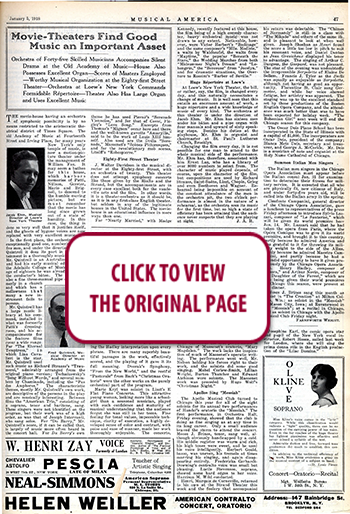 100 YEARS AGO IN MUSICAL AMERICA (224)
100 YEARS AGO IN MUSICAL AMERICA (224)
January 5, 1918
Page 47
Movie-Theaters Find Good Music an Important Asset
Orchestra of Forty-five Skilled Musicians Accompanies Silent Drama at the Old Academy of Music—House Also Possesses Excellent Organ—Scores of Masters Employed—Worthy Musical Organization at the Eighty-first Street Theater—Orchestra at Loew’s New York Commands Formidable Répertoire—Theater Also Has Large Organ and Uses Excellent Music
THE movie-house having an orchestra of symphonic possibility is by no means restricted to the aristocratic theatrical district of Times Square. The old Academy of Music at Fourteenth Street and Irving Place, for many years New York’s only temple of music, is now a motion-picture theater under the management of William Fox. It may seem a bathos for this house, which harbors memories of Patti, Nillson, Gerster, Mario and Brignoli, to descend to the humble moving picture, but we must remember that the movie has long since grown out of a state of humility. In this case, the thing is done so very well that it justifies itself, and the ghosts of bygone voices are now replaced with very excellent music.
In the first place, the orchestra is an exceptionally good one, numbering forty-five men, and under the direction of Fred Quintrell it does its part in the entertainment in a thoroughly musicianly way. Mr. Quintrell is an Australian by birth and had his early musical education at the Adelaide College of ·Music. At the age of eighteen he was already wielding the conductor’s bâton. The house has also a fine three-manual pipe organ formerly in a church and which has a mellowness that many a new instrument fails to possess.
Mr. Quintrell has a large music library at his command, installed in what was formerly Patti’s dressing room, and his accompaniments for the feature films cover a wide range. For “The Eternal Temptress,” in which Lina Cavalieri is the star, Mr. Quintrell used such music as Richard Strauss’s “Traumerei,” admirably arranged from the original piano version; Tschaikowsky’s “Song Without Words,” and several numbers by Chaminade, including the “Pas des Amphores.” The characteristic themes, mostly Mr. Quintrell’s own work, are descriptive of the persons in the play and are musically interesting. Between films the “American Trio,” consisting of a soprano, tenor and baritone, sang. These singers were not identified on the program, but their work was of a high order, as was that of Joseph Interranti, who sang solos. For “Du Barry,” Mr. Quintrell’s score, if it can be called that, is largely of music more often heard in the concert hall. ForDu Barry’s own theme he has used Pierné’s “Serenade Viennoise,” and for that of Cossé, Flégier’s “Love Song.” Excerpts from Thomas’s “Mignon” occur here and there, and the well-known gavotte “Amaryllis,” said to be the work of Louis XIII himself. Also used are the Drdla “Serenade,” Massenet’s “Scènes Pittoresques,” and for the revolutionary mob scenes, Litolff’s “Robespierre.”
Eighty-First Street Theater
J. Walter Davidson is the musical director at the Eighty-first Street, with an orchestra of twenty. This theater does not attempt symphony concerts like those given by the Rialto and the Strand, but the accompaniments are in every case excellent both for the vaudeville acts and the film. In other words, it is a theater-orchestra as it should be, as it is in any first-class English theater hut seldom in any of the legitimate houses in the United States. The movie-house is an educational influence in more ways than one.
For “Nearly Married,” with Madge Kennedy, recently featured at this house, the film being of a high comedy character, heavy orchestral music was not drawn to any extent. Noticeable, however, were Victor Herbert’s “Badinage” and the same composer’s “Mlle. Modiste,” a waltz by Waldteufel, the waltz from “Maytime,” the popular “Beneath the Stars,” the Wedding Marches from both “Midsummer Night’s Dream” and “Lohengrin,” the “Berceuse” from “Jocelyn,” and for dramatic situations, the Overture to Rossini’s “Barber of Seville.”
Huge Répertoire at Loew’s
At Loew’s New York Theater, the bill, or rather, say, the film, is changed every day, and this naturally necessitates a change of music. It is well seen that this entails an enormous amount of work, a huge repertoire and a wide knowledge of music of every kind. The orchestra at this theater is under the direction of Jacob Ehm. Mr. Ehm has sixteen men under his bâton and a pipe organ with four manuals and upward of sixty speaking stops. Besides his duties at the playhouse, Mr. Ehm is organist and choirmaster at St. Paul’s Lutheran Church, Brooklyn. Changing the film every day, it is not possible for one man to attend to the whole·musical side of the performance. Mr. Ehm has, therefore, associated with him Ernst Luz, who has a library of over 8000 numbers to select from. The character of music played depends, of course, upon the character of the film, but compositions are used by Richard Strauss, Saint-Saëns, Liszt, Chopin, Grieg and even Beethoven and Wagner. Rehearsal being impossible on account of the constant attendance of the men in the orchestra pit, the two o’clock performance is almost in the nature of a rehearsal, as the orchestra sees its music for the first time, but so high a state of efficiency has been attained that the audience never suspects that they are playing at sight. —J. A. H.




 RENT A PHOTO
RENT A PHOTO





